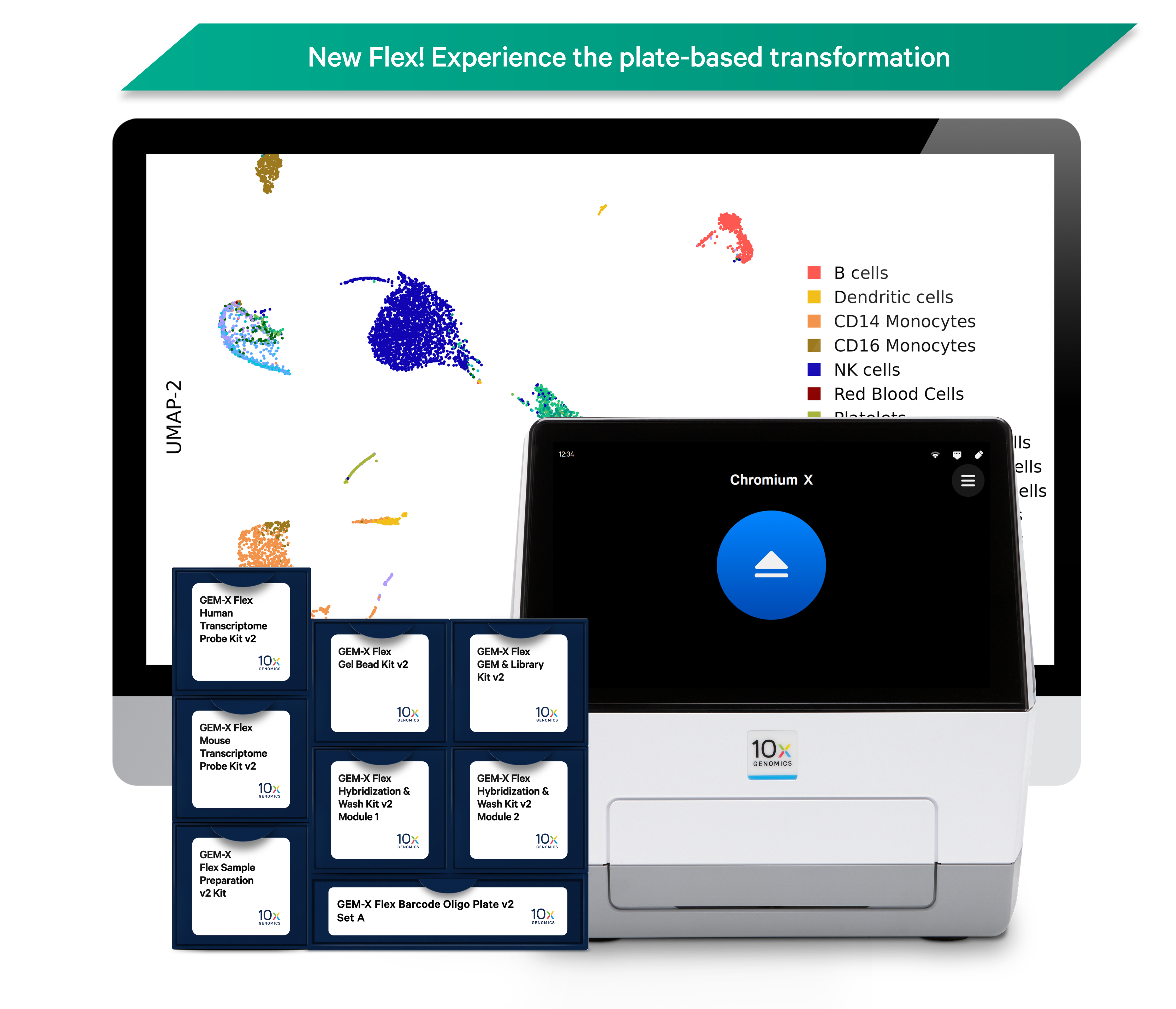Chromium Single Cell
Flex
Plate-based sample handling brings unprecedented scale to highly sensitive single cell profiling
Up to 384 samples a week in 96-well format
Exceptional performance with challenging samples

Why choose Flex
Assay specifications
Species
Compatible samples
Multiomics
Compatible instruments
Throughput options
Singleplex
Plate-based multiplexing
Components
Each experiment requires a chip, index kit, and core reagents. If you're unsure what you need, use the experiment builder find the custom list of items required for your experiment.
Consumables
Choose a version
Nuclei Isolation (optional)
1000494
Chromium Nuclei Isolation with RNase Inhibitor Kit, 16rxns
Sample Prep Kit
1000781
GEM-X Flex Sample Preparation v2 Kit, 48 rxns
Individual Wash Workflow (optional)
1000828
GEM-X Flex Supplemental Wash Kit, 64 rxns
Chip
1000791
GEM-X Flex Gene Expression Chip Kit, 4 chips
Index Kit
1000251
Dual Index Kit TS Set A, 96 rxn
1000215
Dual Index Kit TT Set A 96 rxns
1000250
Dual Index Kit TN Set A, 96 rxn
Core Reagents
1000926
GEM-X Flex v2 Human, 4 samples
1000927
GEM-X Flex v2 Human, 16 samples
1000928
GEM-X Flex v2 Human, 96 samples
1000929
GEM-X Flex v2 Human, 384 samples
1000930
GEM-X Flex v2 Mouse, 4 samples
1000931
GEM-X Flex v2 Mouse, 16 samples
1000932
GEM-X Flex v2 Mouse, 96 samples
1000933
GEM-X Flex v2 Mouse 384 samples
1000919
GEM-X Flex Gel bead & Library Kit v2, 4 rxn
Additional Reagents
1000900
GEM-X Flex Human Transcriptome Probe Kit v2, 16 samples
1000902
GEM-X Flex Mouse Transcriptome Probe Kit v2, 16 samples
1000937
GEM-X Flex Core Reagent Bundle v2, 96 rxns
Feature Barcoding Kit (optional)
1000628
Fixed RNA Feature Barcode Multiplexing Kit, 64 rxns
RNase Inhibitor (Optional)
1000887
Kit, RNase Inhibitor 40x
Documents and resources
Product sheet
User guides
Sequencing requirements
Minimum 10,000 read pairs/cell for gene expression; 5,000 read pairs/cell for protein analysis.
View allDemonstrated protocol
Videos
How it works: Next GEM Flex
Change the rules for scRNA-seq: Access more samples, run on your schedule
Single cell analysis of FFPE tissue: Experiences and considerations from a pathologist’s perspective
Direct fixation of whole blood for downstream single cell analysis
High-throughput single cell profiling with streamlined workflows and multiomic readouts at unparalleled scale
Data analysis
Loupe Browser
Desktop application for Windows and MacOS that allows you to interactively visualize data.
Download Loupe BrowserCloud Analysis
Cloud Analysis enables quick and easy access to Cell Ranger pipelines from your web browser
Learn more about Cloud AnalysisFeatured publications
Single-cell systems pharmacology identifies development-driven drug response and combination therapy in B cell acute lymphoblastic leukemia
Cancer Cell, 2024
Xin Huang, et al.
Peroxisome deficiency underlies failures in hepatic immune cell development and antigen presentation in a severe Zellweger disease model
Cell Reports, 2024
Brendon D Parsons, et al.
Cortical somatostatin long-range projection neurons and interneurons exhibit divergent developmental trajectories
Neuron, 2023
Josephine Fisher, et al.
Featured datasets
10k Mouse Forebrain FFPE Tissue Dissociated using gentleMACS Dissociator, Singleplex Sample
View datasetAggregate of ~900k Human Non Small Cell Lung Cancer and Normal Adjacent Cells, Multiplexed Samples, 16 Probe Barcodes
View dataset128k Human PBMCs Stained with TotalSeq™-C Human Universal Cocktail
View datasetHuman Ovarian Cancer FFPE Single Cell Gene Expression Flex
View datasetAggregate of Human PBMC Isolated from Fixed Whole Blood of a Diseased Donor and a Healthy Donor
View datasetRelated products
Universal 3'
3' gene expression profiling at scale with single cell resolution.
Universal 5'
5' gene expression alongside V(D)J repertoire profiling and antigen specificity of T and B cells.
Epi Multiome ATAC + Gene Expression
Combined profiling of 3' gene expression and chromatin accessibility from the same cell.
Epi ATAC
Chromatin accessibilility profiling at the single cell level.